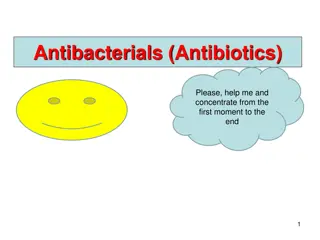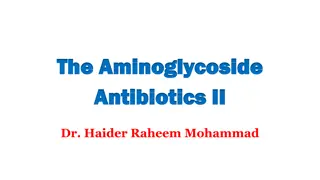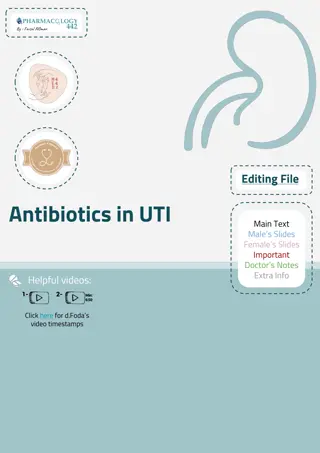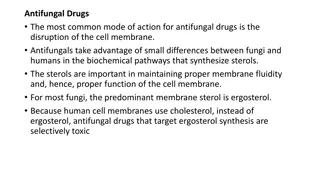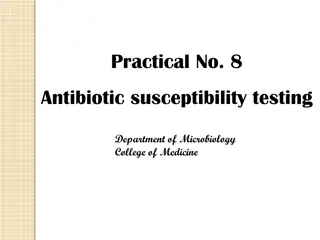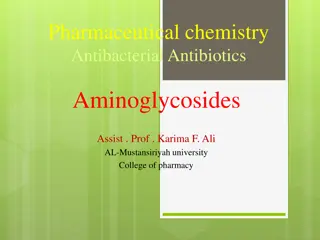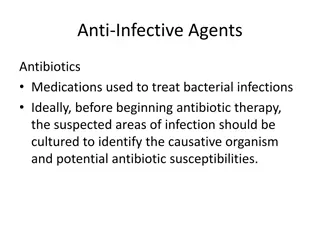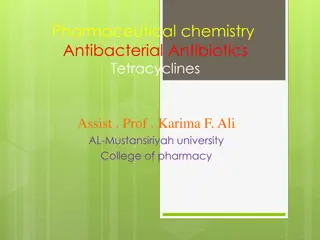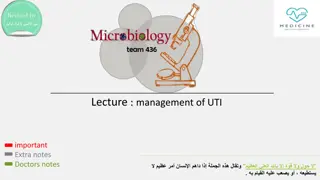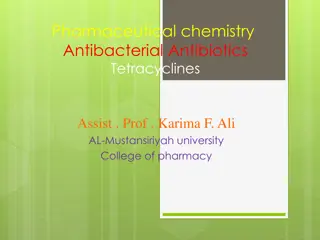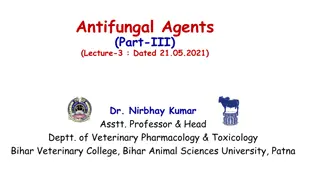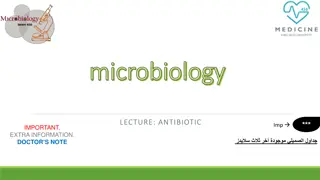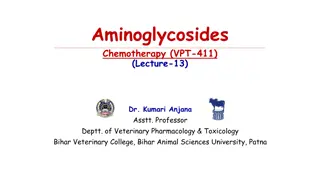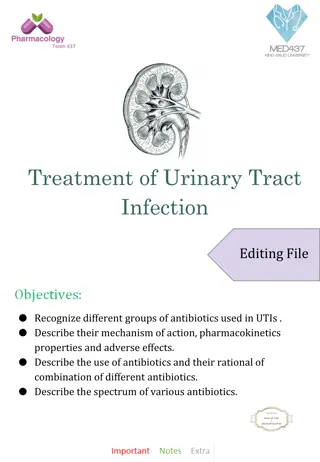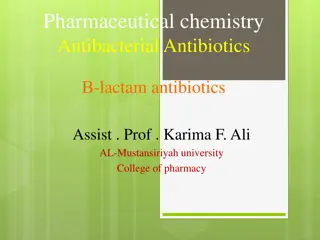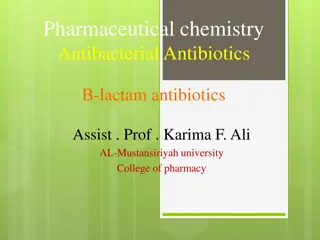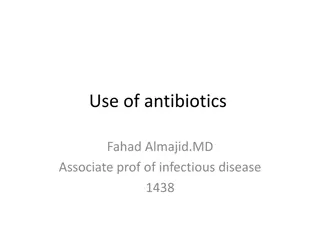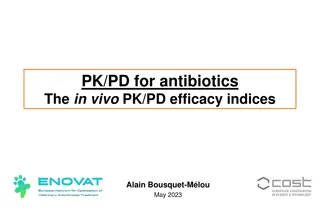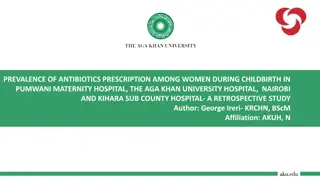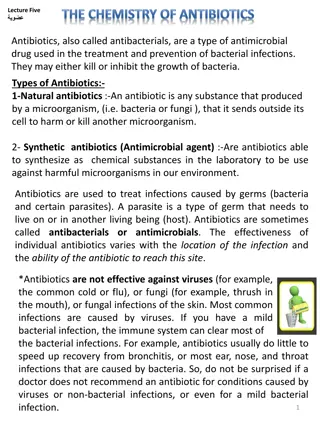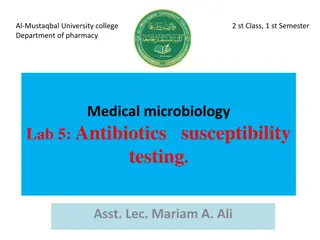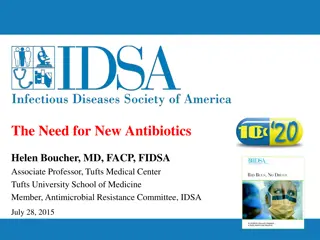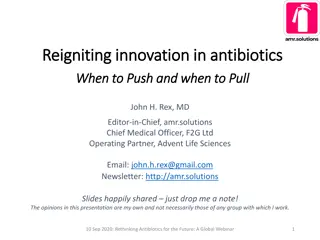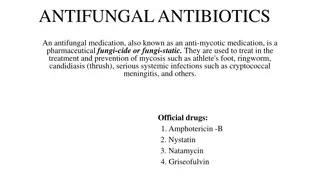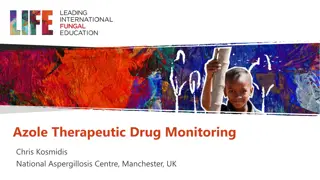Understanding Beta-Lactam Antibiotics: From Penicillin to Carbapenem
Explore the fascinating world of beta-lactam antibiotics, from the discovery of Penicillin by Alexander Fleming to the different classes like Cephalosporin, Penams, and Carbapenem. Learn about the common structure of beta-lactam rings and how they inhibit bacterial cell wall synthesis. Dive into the
1 views • 16 slides
Introduction to Biotechnology in Pharmaceutical Sciences: A Comprehensive Overview by Swarnakshi Upadhyay
Biotechnology in pharmaceutical sciences encompasses the application of scientific and engineering principles to utilize biological agents for various services. It includes molecular biology for production of pharmaceuticals like antibiotics, proteins, and enzymes, as well as large-scale production
0 views • 9 slides
Insights into Antibacterials: Mechanisms and Resistance
Antibiotics play a crucial role in combating microbial infections, but the emergence of antimicrobial resistance poses a significant challenge. Understanding the mechanisms by which antibacterial agents work, such as inhibiting cell wall synthesis, disrupting protein synthesis, and inhibiting metabo
9 views • 51 slides
Understanding Aminoglycoside Antibiotics and Dosing Strategies
Aminoglycoside antibiotics are potent but require precise dosing due to variability among patients. Suggested dosing adjustments based on serum concentrations can ensure therapeutic levels without toxicity. Various methods, like linear pharmacokinetics, individualized dosing, and computerized progra
16 views • 71 slides
Understanding Urinary Tract Infections (UTIs) and Antibiotics: A Comprehensive Overview
Urinary Tract Infections (UTIs) are a common issue, more prevalent in women, with causes ranging from poor hygiene to underlying health conditions. The content delves into the classification of UTIs, their main causes, and bacteria responsible for infections. It also covers the complications of UTIs
0 views • 12 slides
Perspectives on Antibiotics Use in Dairy Production
Dairy farmers use antibiotics to treat sick cows for improved animal welfare; organic dairy farmers face restrictions but benefit from higher premiums; concerns about antibiotic resistance in children debunked by medical professionals; milk processors prioritize food safety through rigorous testing
0 views • 6 slides
Understanding Antifungal Drugs: Modes of Action and Applications
Antifungal drugs target ergosterol biosynthesis in fungi, disrupting cell membrane integrity. Imidazoles like miconazole and ketoconazole are commonly used for skin infections, while triazoles such as fluconazole treat systemic yeast infections. Allylamines inhibit ergosterol synthesis, with terbina
0 views • 13 slides
Understanding Antibiotic Susceptibility Testing
Antibiotic susceptibility testing is crucial in determining the effectiveness of antibiotics against specific bacteria. The Kirby-Bauer method, a standardized paper disk agar diffusion method, is commonly used for this purpose. By observing zones of inhibition around antibiotic disks on agar plates,
1 views • 21 slides
Understanding Aminoglycoside Antibiotics in Pharmaceutical Chemistry
Aminoglycoside antibiotics like streptomycin, kanamycin, neomycin, and gentamicin are vital in treating serious infections caused by Gram-negative bacteria. Their mechanism of action involves inhibiting protein synthesis in bacteria. These medications are poorly absorbed orally but are effective aga
0 views • 26 slides
Understanding Antibiotics: Nursing Implications and Therapeutic Considerations
Antibiotics are essential medications used to treat bacterial infections. Before initiating antibiotic therapy, it is crucial to culture the suspected infection sites to identify the causative organism and select appropriate antibiotics. Nursing implications include assessing for drug allergies, mon
0 views • 8 slides
Understanding Tetracyclines: Antibacterial Agents in Pharmaceutical Chemistry
Tetracyclines, a group of broad-spectrum antibiotics, play a vital role in pharmaceutical chemistry. This article delves into the complex stereochemistry, structures, and reactivity of tetracyclines, highlighting their importance in combating bacterial infections. Explore the unique characteristics
0 views • 25 slides
Management of Urinary Tract Infection: Important Notes and Guidelines
Understanding the management of urinary tract infections (UTI) is crucial for healthcare professionals. The main goal is to eradicate offending organisms using antibiotics, which vary based on factors like infection type and patient profile. Treatment duration and antibiotic choices differ for relap
0 views • 16 slides
Understanding Tetracyclines: Antibiotics in Pharmaceutical Chemistry
Tetracyclines are a vital group of broad-spectrum antibiotics with complex stereochemistry, structural characteristics, and reactivities. Researchers have developed more stable derivatives such as methacycline, doxycycline, and minocycline to address unfavorable reactions. These compounds play a cru
4 views • 22 slides
Understanding Azole Antifungal Agents for Veterinary Use
Azole antifungal agents play a crucial role in treating fungal infections in veterinary medicine. Imidazoles like clotrimazole and triazoles like fluconazole are commonly used for their fungistatic properties. These agents inhibit fungal enzymes, disrupting membrane fluidity and inhibiting cell repl
1 views • 14 slides
Understanding Antibiotics: Mechanisms of Action and Therapeutic Index
Antibiotics play a crucial role in combating microbial infections by either killing or inhibiting bacteria. This lecture covers important topics such as the difference between bactericidal and bacteriostatic antibiotics, spectrum of activity, and the therapeutic index. It also explores the mechanism
0 views • 23 slides
Understanding the Treatment of Respiratory Tract Infections: Antibiotics and Management
This lecture covers the classification of respiratory tract infections and the antibiotics commonly used to treat them. It highlights the types of infections caused by viruses and bacteria, along with their respective treatments. The mechanism of action and pharmacokinetics of antibiotics, such as p
0 views • 7 slides
Understanding Aminoglycosides in Veterinary Pharmacology
Aminoglycosides are a crucial group of antibiotics in veterinary medicine, known for their bactericidal properties and shared chemical characteristics. This class of drugs has a rich history, with members like streptomycin, neomycin, kanamycin, gentamicin, and amikacin. Chemistry-wise, aminoglycosid
2 views • 40 slides
Antibiotics for Urinary Tract Infections: Mechanism, Pharmacokinetics, and Use
Urinary tract infections (UTIs) are common, with various bacteria causing the infection. Different groups of antibiotics are used to treat UTIs, each with its mechanism of action, pharmacokinetic properties, and adverse effects. Antibiotics such as Co-trimoxazole, Nitrofurantoin, and Cephalosporins
0 views • 16 slides
Understanding Beta-Lactam Antibiotics in Pharmaceutical Chemistry
Antibiotics, particularly beta-lactam antibiotics, play a vital role in combating bacterial infections. This article explores the definition, classification, and mechanism of action of antibiotics. It delves into the structural features of penicillins, emphasizing the importance of the beta-lactam r
0 views • 84 slides
Understanding Antibacterial -lactam Antibiotics in Pharmaceutical Chemistry
In the realm of pharmaceutical chemistry, the significance of antibiotics, particularly -lactam antibiotics, is explored. Antibiotics play a crucial role in inhibiting and combating the growth of microorganisms. This article delves into the definition of antibiotics, their classification criteria, m
0 views • 88 slides
Best Practices for Antibiotic Use in Infectious Diseases Management
Antibiotics play a crucial role in preventing and treating diseases, but misuse and overprescription are common issues. Dr. Fahad Almajid emphasizes the importance of accurate diagnosis, host factors consideration, and microbiology testing for effective treatment. Identifying life-threatening infect
0 views • 51 slides
Understanding PK/PD Approach for Antibiotics: In Vivo Efficacy Indices
Exploring the PK/PD approach for antibiotics involves considering factors such as dose administered, in vitro therapeutic effect, MIC, rates of bacterial killing, and plasma concentrations to predict treatment efficacy. The location of pathogens, binding to plasma proteins, and tissue concentrations
0 views • 27 slides
Understanding PK/PD for Antibiotics: In Vivo Efficacy Indices
This information delves into the PK/PD approach for antibiotics, emphasizing the importance of plasma concentrations in controlling infection site concentrations, details on pathogen locations, binding to plasma proteins, and the significance of tissue concentrations for predicting treatment efficac
1 views • 27 slides
Prevalence of Antibiotics Prescription Among Women During Childbirth: A Retrospective Study
This retrospective study aimed to define the prevalence and types of antibiotics prescribed, timing, and duration of prescription for mothers during childbirth at Pumwani Maternity Hospital, The Aga Khan University Hospital in Nairobi, and Kihara Sub-County Hospital. The study focused on determining
0 views • 9 slides
Hot Topics in Hospital Medicine 2019: Endocarditis Treatment Dilemma
An active heroin user with endocarditis raises the question - should the patient stay in the hospital for IV therapy or be discharged with oral antibiotics? A randomized trial explores the feasibility of switching to oral antibiotics with similar outcomes. Inclusion criteria detail stability require
0 views • 104 slides
Understanding Antibiotics: Types, Mechanisms, and Usage
Antibiotics, or antibacterials, are essential antimicrobial drugs used to treat and prevent bacterial infections. They work by either killing or inhibiting the growth of bacteria. They are classified based on factors like mechanism of action, chemical structure, and spectrum of activity. Factors inf
0 views • 5 slides
Antibiotics in Primary Care: Balancing Benefits and Risks
Antibiotics play a crucial role in healthcare, but their overuse can lead to medicalization of illnesses and unnecessary prescriptions. Evidence suggests limited symptom relief from antibiotics in certain conditions. Delayed or back-up prescriptions are recommended to reduce unnecessary antibiotic u
0 views • 34 slides
Understanding Antibiotic Susceptibility Testing in Medical Microbiology Lab
Antibiotics are chemical substances produced by microorganisms to inhibit or kill other microorganisms. In the lab, antibiotics susceptibility testing is conducted using the Disc Diffusion method (Kirby-Bauer method) on agar plates. The sensitivity of bacteria to antibiotics is determined by measuri
0 views • 11 slides
Management of Uncomplicated Sore Throat with a New Quick PCR Point-of-Care Test
A prospective study explored the utility of a high-sensitivity PCR test for Group A Streptococci in managing uncomplicated sore throats. Findings showed reduced antibiotic prescribing rates and targeted treatment, emphasizing the importance of testing patients and prescribing antibiotics based on te
0 views • 4 slides
Antibiotics: Past, Present, and Future Developments in Medicine
Over the course of history, significant advancements have been made in the field of medicine regarding the understanding and treatment of infectious diseases. From key developments like immunization by Edward Jenner to the discovery of penicillin by Fleming and the subsequent development of antibiot
0 views • 30 slides
Understanding Antibiotics: Types, Mechanisms, and Testing
Antibiotics are compounds produced by living organisms that inhibit or kill other organisms, categorized as bactericidal or bacteriostatic. This article explores the types of antibiotics, mechanisms of action against bacteria, and the importance of sensitivity testing to determine drug effectiveness
0 views • 22 slides
The Urgent Need for Developing New Antibiotics
Antibiotic resistance has led to devastating consequences, with lives lost and individuals suffering from resistant infections. This urgency is highlighted through real-life cases of individuals facing complications due to antibiotic-resistant bacteria. The narrative follows a 46-year-old man with e
0 views • 19 slides
Innovating Antibiotic Research & Development: The POWER Act Impact
Increased investment in antibiotics and overcoming barriers to development are crucial to combat rising antibiotic resistance. The PATH Act aims to rejuvenate antibiotic R&D by addressing challenges such as competition for funding, limited pipeline drugs, and difficulty in conducting trials due to a
0 views • 11 slides
Antibiotic Stewardship Awareness Event at University of Pittsburgh
Annual Get Smart Week event at University of Pittsburgh focusing on antibiotic stewardship to raise awareness about the problem of antibiotic resistance. The event featured Dr. Karen Hacker from the Allegheny County Health Department and highlighted the importance of proper antibiotic use to combat
0 views • 6 slides
Understanding Antibiotics and Their Effects on Germs
Explore the world of antibiotics and their impact on bacteria, fungi, viruses, and mild bacterial infections. Delve into the chemistry of antibiotics, their mechanisms, and how they combat various germs. Learn about the treatments involving antibodies and specific conditions like Helicobacter pylori
0 views • 18 slides
Breastfeeding Common Problems and Solutions
Breastfeeding can present various challenges such as latching issues, cracked nipples, engorgement, mastitis, low milk supply, thrush, and inverted nipples. Effective strategies include proper positioning, soothing gel pads, hand-expressing milk, antibiotics, frequent nursing, antifungal treatment,
0 views • 9 slides
Reigniting Innovation in Antibiotics: When to Push and When to Pull
John H. Rex, MD discusses the importance of antibiotics in healthcare, emphasizing the need for innovation. He explores the concepts of pushing and pulling in antibiotic development and challenges the audience to rethink the use of antibiotics for the future. The presentation covers fundamental poin
0 views • 15 slides
Understanding Antifungal Inhibitors and Drugs
In this detailed overview, we explore antifungal inhibitors and drugs, including their mechanisms of action, impact on eukaryotes and prokaryotes, common agents affecting fungal sterols and cell walls, as well as synthetic antifungals. From polyenes like nystatin to azoles such as voriconazole, this
0 views • 12 slides
Overview of Antifungal Antibiotics and Their Uses
Antifungal antibiotics are crucial medications used to treat and prevent various fungal infections such as athlete's foot, ringworm, candidiasis, and systemic infections like cryptococcal meningitis. This article discusses key antifungal medications including Amphotericin-B, Nystatin, Natamycin, and
0 views • 6 slides
Understanding Azole Therapeutic Drug Monitoring for Antifungal Therapy
Azole therapeutic drug monitoring (TDM) is crucial for managing antifungal therapy due to factors like drug interactions, compliance issues, disease severity, and pharmacokinetic variability. This monitoring helps ensure optimal drug levels are maintained for effective treatment. Different TDM metho
0 views • 18 slides


